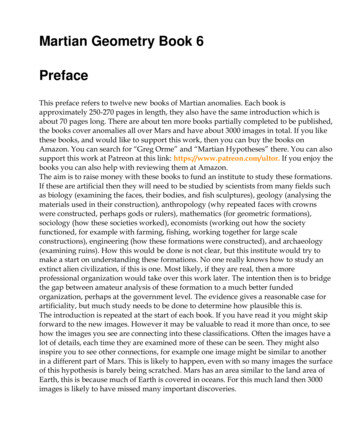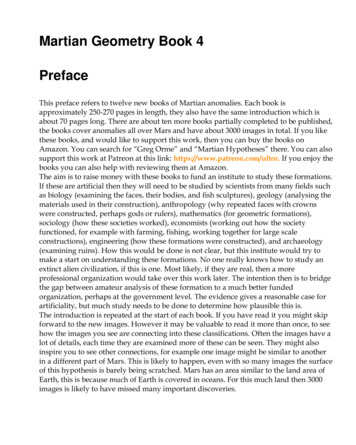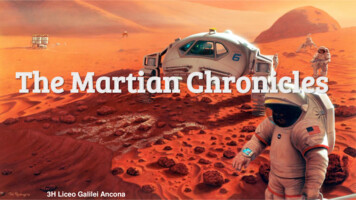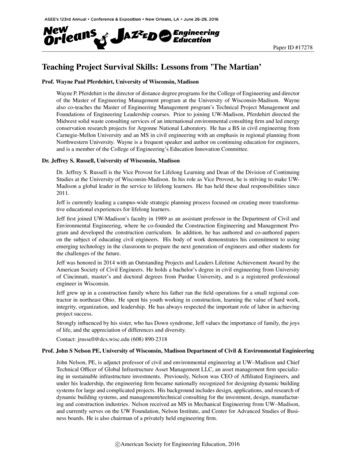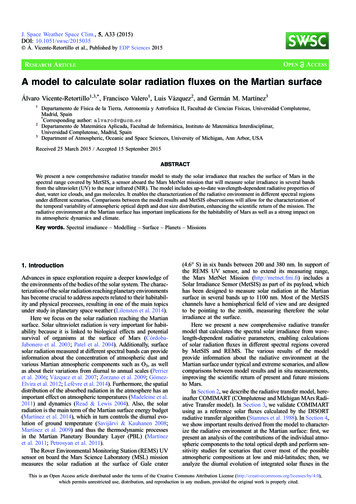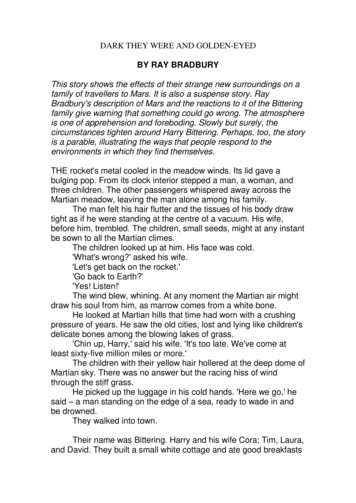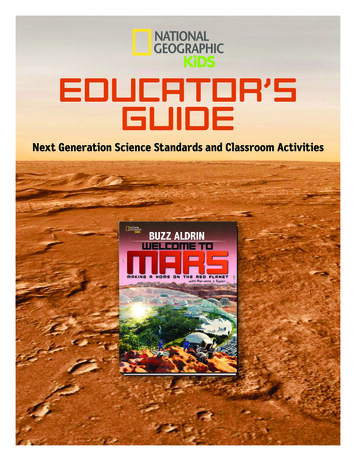
Transcription
Martian Hypotheses Book 10PrefaceThis preface refers to twelve new books of Martian anomalies. Each book isapproximately 250-270 pages in length, they also have the same introduction which isabout 70 pages long. There are about ten more books partially completed to be published,the books cover anomalies all over Mars and have about 3000 images in total. If you likethese books, and would like to support this work, then you can buy the books onAmazon. You can search for “Greg Orme” and “Martian Hypotheses” there. You can alsosupport this work at Patreon at this link: https://www.patreon.com/ultor. If you enjoy thebooks you can also help with reviewing them at Amazon.The aim is to raise money with these books to fund an institute to study these formations.If these are artificial then they will need to be studied by scientists from many fields suchas biology (examining the faces, their bodies, and fish sculptures), geology (analysing thematerials used in their construction), anthropology (why repeated faces with crownswere constructed, perhaps gods or rulers), mathematics (for geometric formations),sociology (how these societies worked), economists (working out how the societyfunctioned, for example with farming, fishing, working together for large scaleconstructions), engineering (how these formations were constructed), and archaeology(examining ruins). How this would be done is not clear, but this institute would try tomake a start on understanding these formations. No one really knows how to study anextinct alien civilization, if this is one. Most likely, if they are real, then a moreprofessional organization would take over this work later. The intention then is to bridgethe gap between amateur analysis of these formation to a much better fundedorganization, perhaps at the government level. The evidence gives a reasonable case forartificiality, but much study needs to be done to determine how plausible this is.The introduction is repeated at the start of each book. If you have read it you might skipforward to the new images. However it may be valuable to read it more than once, to seehow the images you see are connecting into these classifications. Often the images have alot of details, each time they are examined more of these can be seen. They might alsoinspire you to see other connections, for example one image might be similar to anotherin a different part of Mars. This is likely to happen, even with so many images the surfaceof this hypothesis is barely being scratched. Mars has an area similar to the land area ofEarth, this is because much of Earth is covered in oceans. For this much land then 3000images is likely to have missed many important discoveries.
You can also use the indexes in each book, they refer to many similar formationsthroughout them. For example, if you are looking at hypothetical road formations thenroads in many different areas can be found in the indexes. It would be possible then toquickly see all the different kinds of hypothetical roads in all 10 books. The idea behindthe introduction is to give an outline to the global hypothesis, how these differentformations connect together into a hypothetical Martian civilization. It’s important thento get an intuition of how these formations connect together globally.Some areas for example might have hypothetical roads for transport, other might havehypothetical tubes like a covered road. Different terrain, available materials, and climatemight have led to one being used over the other. It may be as Mars cooled it becamenecessary to travel under cover because of the cold. Another possibility is predators ormeteors made traveling on roads too dangerous. Also there are many hypothetical damformations, but the construction techniques vary between areas. Some are formed withdam walls attached to the crater, when they break some show a cavity under them andothers do not. This would indicate the dam wall was dug into this cavity to keep it fromsliding down the crater wall. In other areas this was not necessary, it may be that therethe crater wall was harder rock which the dam wall could be cemented to. Some showcolumns and layers in them but others have evenly spaced vertical grooves on the damwalls. Some dams are excavated out of the crater wall or the material at the bottom of thecrater, these may depend on the rock type in the crater. For example, if the crater wall istoo easily broken then an excavated dam might have been the best engineering solution.Some areas have hollow hills, these are where a hollow habitat may have been built on anexisting hill or the whole hill was constructed. In some areas these have layers similar to aCobler Dome, this is where bricks form the dome in decreasing circles as the dome isbuilt up. These are called amphitheatres as a friendly name, the first amphitheatreformation looked more like seating around an amphitheatre. Other hypotheticalbuildings have no layers in their roofs. This may have depended on the materialsavailable. Many appear to have a smooth skin like cement which has broken up in someparts of the roof, and is intact in others. In many areas this is more intact on the southernside, as the skin breaks off the softer inner parts of the roof appear to have eroded fasterand collapse. The one sided erosion may imply a prevailing wind, or as the oceans andair froze at the pole this created the erosion.There are also large areas of walls and room like shapes, these are hypothetical cities.Other areas connect these hollow hills together with tubes or roads as another kind ofhypothetical city. Still others seem to be made of tubes that connect together inintersections called a tube nexus. This may have been because of the climate further fromthe equator, for example tubes might have been used to travel through in colder areas.
The Martian Faces are mainly discussed in books 11 and 12, a reprint of published peerreviewed papers. These differ according to where they are. The Cydonia Face, Nefertiti,and King Face all fall on a great circle, this is hypothesized to have been an old equatorthat lines up with a known previous pole position west of Hellas Crater. The newlydiscovered Queen Face is in Cydonia but not near the old equator. If the faces were usedto mark latitudes and longitudes then the overall system remains obscure. For examplethere is a large hyperbola shown close to the old equator. Another is far from thisequator, but drawing a line from it to Nefertiti gives a right angle to this old equator.Joining these two hyperbolas and the King Face gives an Isosceles Triangle. Thehypothesis of these mapping system is highly speculative at this stage.Canals, lakes, and water channels also vary in different areas. West of Cydonia there is anextensive array of hypothetical canals, also east and west of Elysium Mons. Some of theseconnect to larger lakes which may be artificial. Some hypothetical dams have waterchannels to direct water into a dam, and to collect an overflow to another dam.There are also darker areas often bounded by walls or geometric shapes. These may havebeen farms, why they appear in some areas like around Cydonia and in Isidis remainsunanswered. Other areas contain hypothetical artefacts but no farm formations, so thesecreatures would have used a different way of collecting food.The idea of these books then is not just to prove artificiality, but to try to prove a globalhypothesis of how the whole civilization functioned. Once the evidence becomesplausible enough, and the shock wears off, this larger question is much more interesting.Each section is labelled with the title hypothesis to make clear these notions are beingproposed along with the evidence there. The sections all have many keywords connectingto the index. If you see a connection to a kind of formation then it is easy to find similarformations. In seeing the global hypothesis the different pieces of the puzzle are morelikely to come together, for example the hypothesis of dams sounds less plausible if it isnot connected to the hypothesis of buildings and farms. Together they give the ideas ofhabitation, food, and water. The conclusions can be controversial. However there is somuch evidence it was better to put it all together into a more comprehensive hypothesis.Otherwise people are looking at isolated formations like faces without seeing the overallcontext in which they appear.Cymhh473j
HypothesisA and B shows walls in a triangle.Cymhh473kHypothesis
A shows a road or collapsed tube, this continue soon to C at 6 o’clock. From 2 o’clock aroad goes up to B connecting to several hollow hills. D and E show more tubesconnecting to a hill.The next section analyzes an area calledProtonilusPrca475HypothesisThese water channels have a ridge going down the middle. A shows some unusual darkspots perhaps related to habitats. B shows show this side of the channel is quite even asdoes C. Other areas have had a tube inside a channel like this, in several areas the insideswere exposed.
Prca477HypothesisA related ridge or tube in this area, it may go down into the ground on both sides. A andB show dark spots like the roof is collapsed. B at 2 o’clock looks hollow in the center.
Prca478HypothesisAnother one of these tube shapes, A at 7 o’clock shows where it disappears leaving agroove. This groove then extends into the tube shape at 4 and 5 o’clock, it also seems tohave broken into sections. The groove is problematic because it would have to form in thetube shape as well as in the bare ground, but this would be a different geological process.
Prca479HypothesisThis shows another tube in a channel, or perhaps it was buried and has been exhumed. Aat 8 o’clock looks collapsed in the center as if hollow. At 4 o’clock the banks of thechannel is shown, the bottom of this channel has an unusual texture as seen at C at 9o’clock. B at 1 o’clock sows the other edge of the channel bank, at 1 o’clock there appearsto be regular sections of the tube shape like arches inside it. This is seen in other tubesand may be a construction technique.
Prca479aHypothesisThis is a closeup of one of these channels, the texture is regular like it is made of bricks.Particularly at A at 4 o’clock there seems to be brick like shapes about the same size. At 1o’clock the tube shape in the middle of the channel is shown. The two edges are all that isleft. B shows another hollow section of this, C at 7 o’clock shows a hollow where the tubewould be and at 4 o’clock it is much higher. D shows how there are layers on the sides ofit.
Prca479bHypothesisAnother part of this water channel, the central tube shape has a crack along it at A. Bshows more of these layers along its side. This can be a construction technique, to makelayers of cement in the base.
Prca479cHypothesisSome tubes are shown here, these seem to go across uneven and eroded ground but arein much better condition like cement. B at 6 o’clock shows a fork into two tubes.
Prca479dHypothesisA closeup of brick like shapes in the channel, each piece is around the same size and joinstogether with the others. A water channel should have eroded the rock not broken it upinto brick or tile shapes like this.
Prca480HypothesisMore of these tube shapes, A shows dark spots along it like it is breaking up. B at 9o’clock is like a hollow hill as seen in many other areas, the dark patch on top may be theroof. B at 5 o’clock shows more collapsed areas. C at 7 o’clock shows the bank is welldefined, at 4 and 8 o’clock the tube shape changes from dark to pale. At 10 and 4 o’clockthe bank is also well defined.
Prca480aHypothesisThis part of the tube shape is a near perfect parabola as shown, unlikely to occur bychance. The tube shape is also about the same height and width wherever seen, it doesnot vary much randomly like a natural formation from weather erosion.
Prca481HypothesisThis part of the water channel was transverse stripes or grooves like the bricks arearranged this way. These stripes are all about the same width, not varying randomly, andabout the same height. They have eroded evenly rather than developing pits in thesurface. The central tube shape appears to be breaking up into these dark spots exposinga hollow interior. Between A there is a dark groove along it as if hollow, at 4 o’clock itseems to be broken. B shows pieces like small hills connected together perhaps as aconstruction technique. C shows some of these stripes, they pass right under the centraltube shape, this can be seen by following the lines on both sides. It means then that thecentral tube shape had to come later and was added on top of the stripes. This would behard to explain geologically, how this tube could form on top of the stripes withoutaffecting any of them. Also if the stripes were cracks then the central tube shape shouldchange their course.
Prca483HypothesisThis shows another water channel, the tube shape at A is much more eroded with anintact piece at 8 o’clock, and a collapsed section at 6 o’clock. B appears to be the loweredge of the former tube exposing a hollow or groove that was in it. C shows a sectionwhere this groove is covered over, the angular sections are like bricks. D also shows agroove like bricks.
Prca485HypothesisThe crater ejecta has an unusual shape, the water channel is regular in size at 6 and 7o’clock. The edge of the ejecta at 4 and 5 o’clock is nearly a straight line and steep ratherthan randomly shaped. This ejecta if anything should be more spread out in the channelfrom erosion. B and E also show unusual shapes in the ejecta, it may have been built upinto a hollow hill. C and D also show a regular shaped water channel but with anunusual ejecta shape going into it.
Prca487HypothesisMore tube shapes are shown, at A they have broken up into sections with a line of darksoil under them in the image. B shows similar related shapes, at 9 o’clock this is largerand a hollow hill shape with patches on the roof is at 4 o’clock. At 10 o’clock there mayhave been a tube eroded away. C shows another tube not in a water channel at 7 o’clock,it goes into the larger tube shape on the left. At 8, 10, and 12 o’clock there are more layers,at 5 o’clock it looks like a degraded hollow hill. D shows another tube shape with ahollow interior at 4 and 6 o’clock, more layers at 11 and 1 o’clock. E appears to be anotherlayer, much smoother on top.
Prca488HypothesisThis water channel ends suddenly, this makes it less likely to be natural as water wouldnot stop like this after eroding the channel. A shows layers along the side of the channelat 1 and 2 o’clock, at 3 and 5 o’clock there appears to be a hollow hill. B shows more ofthese layers running along the channel, the dark material at 8 o’clock is like the roof seenon many hollow hills. C shows more of these layers.
Prca489HypothesisThese layers are found along many of these water channels, A shows they go up to thesides connecting to the more natural looking ground. At 5 o’clock there may be theremains of the central tube shape, also seen a B at 11 o’clock. C shows more layers and thecontinuation of this tube shape at 7 o’clock, D shows more layers. The constructiontechnique would be to make a higher layer on the side of the bank, then anotheroverlapping further down like fish scales. This would allow a layer to dry before the nextone was adhered to it. It would also allow a frame to hold the layer of cement in placewhile it dried.
Prhh492HypothesisA at 12 o’clock shows a hollow hill connected to a crater, though the impact should berandom the hill seems to open up and go around the crater rim like it was known to bethere. This happens in nearly every example of a hilled crater, thousands of them. At 1o’clock there may be a collapsed area, at 2 o’clock the hill smoothly joins to the crater rimwith dark material in both of them. A at 4 o’clock shows patches on the roof of anotherhollow hill, perhaps other craters like the two shown were repaired. B shows fine tubeshapes at 4 and 6 o’clock, also a hill surrounding this crater from the left at 1 o’clock. Cshows a small tube into a crater at 10 o’clock and a notch in the crater rim at 2 o’clock. Dshows a smooth artificial looking hill at 8 o’clock, then a smooth area around it likecement at 9 o’clock, above this at 10 o’clock the ground looks like many tubes are underthis smooth skin. E shows more tubes going into the hill.
Prr493HypothesisThis is a road shape going from the hollow hill at A along B into the crater at C. Thiscrater is then connected to another, shown by D perhaps by a hollow hill.
Prr494HypothesisThis shows another road shape, A points to many pits not like typical crater shapes. Theymay have been altered and connected to make bigger dams. B shows a smooth areaaround these at 8 o’clock, then a road or tube at 7 o’clock which has forked into others ofthese. C shows how this road connects into the side of the hill at D, it seems to go insidethe edge of it leaving a groove then continue on through E to the crater at 11 o’clock.
Prr495HypothesisThis shows another road connecting craters from A through B to C, its surface is muchsmoother than the surrounding terrain.
Prc496HypothesisThe crater at A at 9 o’clock has a small hill connected to the crater rim, similar to the oneat 4 o’clock perhaps for access to the water that was inside it. B shows how this crater hasa very unnatural protrusion as if altered. At C the rim seems to extend outwards at 11o’clock and into a tube like shape at 10 o’clock.
Prhh497HypothesisA shows how these two hollow hills are collapsed, at 8 o’clock only the outer wall is left.The craters like at 7 o’clock may have darker repaired areas around them.
Prhh498HypothesisThe hollow hill has collapsed at A, B shows a straight wall still standing. C shows anotherroad going into the hill perhaps with two lanes, this extends to D at 10 and 1 o’clock.There may be another road at 7 o’clock.
Prr499HypothesisThis is a closeup of a road, much smoother than the surrounding terrain like cement. Itextends past A to B where a tube or raised road intersects it. C shows this tube goingdown from 10 o’clock, then possibly at 6 and 7 o’clock into the crater.
Prr500HypothesisAnother road section is shown, A shows a smaller road or collapsed tube at 8 o’clockwhich appears to be directed at the small hill at 6 o’clock. Another hill like this is at B at10 o’clock, there is a smoother flatter area around this from 9 to 11 o’clock. C shows acontinuation of the road, the shadows indicate it is perhaps lower than the surroundingterrain.
Prr501HypothesisA shows the same road going into a crater, it appears to be built up like a hollow hillaround the crater rim. This pale material is different from the darker rim, so it could notbe ejecta. B shows how the road goes over an into this pale material like cement, so itcould not have been a preexisting road hit by a crater. The road had to have been formedafter the crater was. C shows how this pale material goes up to and covers part of thedarker crater rim, this again means it had to come after the crater and so it movedupwards onto the rim against gravity. Around D this pale material is smoother so it maybe cement like the road material. It’s unlikely any other kind of material would havelasted so long.
Prr502HypothesisThis part of the road appears to be more eroded at 4 and 5 o’clock, the crater at 2 o’clockmay have this road material covering it like a dam. B shows a possible tube or secondroad at 9 o’clock going down to C, at 4 o’clock B shows a more intact piece of the roadthat seems to have broken off from both sides.
Prhh503HypothesisA shows another hollow hill, the outside is in good condition but the center appears to becollapsed. It may also be like a walled hill where sometimes the roof sinks lower like acatenary shape. B shows a connection from the crater at 9 o’clock, this is unlikely to occurwith a chance impact as it seems to widen out to meet the crater rim.
Martian Hypotheses Book 10 Preface This preface refers to twelve new books of Martian anomalies. Each book is approximately 250-270 pages in length, they also have the same introduction which is about 70 pages long. There are about ten more books partially completed to be published,

